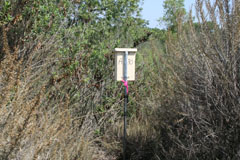-
Published: Aug 29, 2013 | 15:34 PM
About Those Little Bird Houses in the San Joaquin Marsh
 Tree Swallows like to build their nests in the cavities of trees, but if there are no trees, where are the swallows to go? This was a problem looking for a solution at the Irvine Ranch Water District San Joaquin Marsh in the late 1990s.
Tree Swallows like to build their nests in the cavities of trees, but if there are no trees, where are the swallows to go? This was a problem looking for a solution at the Irvine Ranch Water District San Joaquin Marsh in the late 1990s.
“There wasn’t a lot of vegetation at the Marsh to support nesting tree swallows,” said Christine Tisher, volunteer with Sea and Sage Audubon Society and program manager for the nesting box program. “So we started off with about 30 boxes in 1998.”
Tisher, a wildlife biologist by profession, was taking a class on birdcalls from Audubon at the Marsh, when she learned that the new nesting program needed a manager. She raised her hand and has overseen the program ever since.
The little nesting boxes mounted on metal poles are easy to see along the trails through the Marsh. The numbers of the boxes grew over the years to more than 100. A dedicated group of monitors formed under Tisher and they began a regular program to monitor the boxes in 2000.
Tisher has kept copious notes on the nesting box activity over the years. From the years 2000-2012, 3,743 swallows have fledged, 6,734 eggs were laid and 3,779 birds were banded for tracking their movements. Each nest has an average of four to six eggs and four to five actually hatch and survive.
Volunteers monitor the boxes on a weekly basis during the breeding season March through July. They count the number of nests, eggs, chicks and the number of chicks that fledge, or leave the nest. They also ensure that the boxes are in workable condition, trim vegetation from around the boxes, protect the birds from ants, mites and other predators, and record banding information.
One young volunteer learned about the program on the internet and thought it would be a great volunteering opportunity. Joanna Paik, 15, will be a sophomore at Beckman High School in Tustin. She moved to the area last year from Chicago.
“I thought this would be great to help the environment,” she said. “I will do this again next summer.”
Prior to this year’s nesting season, all of the boxes were removed for rehabilitation. The original boxes were all painted light blue. The rehabilitated boxes were repainted red, tan, mustard and blue.
“The style of these boxes is the same that’s used by the western bluebird,” Tisher explained.
There is a protocol for monitoring the boxes. Each box is numbered and volunteers are equipped with clipboards and lists with the numbers of the boxes. If the support pole has a red ribbon tied on it, that means there are older chicks inside ready to fledge. Those boxes are not disturbed.
Swallows aren’t the only species that have called the nesting boxes home. In 2003, one pair of bluebirds successfully nested and fledged three young during the first nesting periods. Two pairs of house wrens and one pair of western bluebirds occupied three boxes during the first nesting period in 2008. One box supported a pair of house wrens during the first nesting period and tree swallows followed in the same box during the second nesting period in 2009.
While it is exciting for the volunteers to see other species using the boxes, it’s the tree swallows that matter most, Tisher said.
“In the 1990s, there were none to be found in Orange County,” she said. “There were some unverified reports from the UC Irvine portion of the Marsh. This program has been successful in getting the tree swallows back to Orange County.”



 Tree Swallows like to build their nests in the cavities of trees, but if there are no trees, where are the swallows to go? This was a problem looking for a solution at the Irvine Ranch Water District San Joaquin Marsh in the late 1990s.
Tree Swallows like to build their nests in the cavities of trees, but if there are no trees, where are the swallows to go? This was a problem looking for a solution at the Irvine Ranch Water District San Joaquin Marsh in the late 1990s.